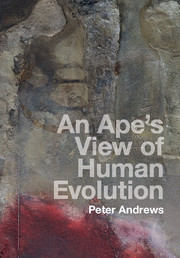Book contents
- Frontmatter
- Contents
- Preface
- 1 How can we recognize common ancestors?
- Part I Apes: their morphology and behaviour
- PART II Environments and palaeoenvironments
- Part III Review of fossil apes
- 7 The view from the early Miocene
- 8 The environment in the early Miocene
- 9 The view from the middle Miocene
- 10 Specialized apes from the middle Miocene
- 11 The environment during the middle Miocene
- 12 A second view from Europe
- 13 The environment in Europe
- 14 Late Miocene to Pleistocene apes
- 15 Apes, hominins and environment in the late Miocene
- Part IV Last common ancestor
- References and further reading
- Index
- References
13 - The environment in Europe
from Part III - Review of fossil apes
Published online by Cambridge University Press: 05 January 2016
- Frontmatter
- Contents
- Preface
- 1 How can we recognize common ancestors?
- Part I Apes: their morphology and behaviour
- PART II Environments and palaeoenvironments
- Part III Review of fossil apes
- 7 The view from the early Miocene
- 8 The environment in the early Miocene
- 9 The view from the middle Miocene
- 10 Specialized apes from the middle Miocene
- 11 The environment during the middle Miocene
- 12 A second view from Europe
- 13 The environment in Europe
- 14 Late Miocene to Pleistocene apes
- 15 Apes, hominins and environment in the late Miocene
- Part IV Last common ancestor
- References and further reading
- Index
- References
Summary
The dryopithecines have been shown in Chapter 12 to have had a distribution across southern Europe, from Spain to Italy (if we accept Oreopithecus as a dryopithecine). They are also known from several sites in Germany across to Georgia, which suggests that they had pretty eclectic environmental requirements. Generally speaking, they are the only fossil ape present at any of the sites, although at several sites they appear to coexist with pliopithecids, which are primitive catarrhines that appear to be strongly arboreal. More than one dryopithecine species may occur at some sites, for example Hostalets de Pierola in Spain, but it is not clear if they come from the same fossiliferous horizon or even the same site within that region.
There is little information about the environment at Saint Gaudens. Regional floras not directly associated with the fossil site suggest warm temperate conditions, with pine, chestnut and oak forming mainly deciduous woodlands similar to the region today. Whether this was anything like the environment occupied by D. fontani must be doubtful for the teeth of this fossil ape have thin enamel, based on measured tooth sections and on the rapid appearance of dentine pits at cusp apices. Thin enamel has been shown earlier to be associated with soft fruit diets, and while soft fruit is seasonally plentiful in temperate woodlands, it is in short supply during the winter.
Rudabánya
One site with abundant dryopithecine fossils is Rudabánya 2 in Hungary. There are a number of other fossiliferous localities within the Rudabánya Basin, including a site with well-preserved fossil leaves. The sites were formed on gently sloping land incised by valleys draining into a large lake that now forms the Pannonian Plain in northern Hungary. The fossil sites were located in some of these valleys. Here I am describing the excavations at Rudabánya 2, but the depositional setting of the other sites is broadly equivalent and they will be mentioned briefly when reconstructing the landscape ecology of the region during the Miocene.
The Rudabánya 2 deposits were laid down in a shallow valley running approximately east to west into the ancient Pannonian Lake. The Pannonian Basin in the late Miocene was enclosed by the Carpathians to the north and east and by the Alps to the west.
- Type
- Chapter
- Information
- An Ape's View of Human Evolution , pp. 200 - 210Publisher: Cambridge University PressPrint publication year: 2016



